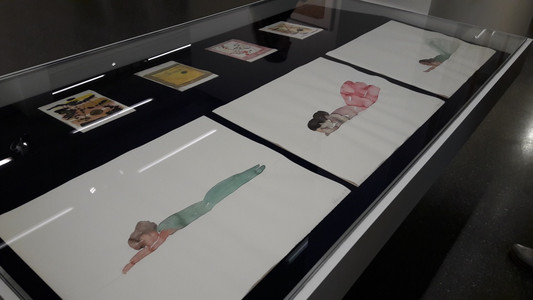300 Meisterwerke der Gegenwartskunst
Papier ist einfach zu nutzen und zugleich experimentell. Es hat eine unprätentiöse, intime Aura, es ist subtil und haptisch. Papier ist auch im Zeitalter der Digitalisierung das Medium, auf dem sich Welten abbilden lassen: Mit rund 300 Highlights und Neuentdeckungen aus der Sammlung Deutsche Bank zeigt The World on Paper, welche Faszination das Medium Papier auf Künstler seit der Nachkriegsmoderne ausübt und wie dieses sinnliche und zugleich pragmatische Material immer wieder neue gestalterische Möglichkeiten eröffnet.
Zugleich verdeutlicht die Ausstellung auch die globale Ausrichtung der Sammlung Deutsche Bank – insgesamt umfasst die Auswahl 133 Künstlerinnen und Künstler aus 34 Ländern, darunter Doug Aitken, Joseph Beuys, Ellen Gallagher, Sigmar Polke, Dieter Roth und Atsuko Tanaka.
Die früheste Arbeit der Schau ist eine Zeichnung von Maria Lassnig von 1948, während das jüngste Werk von Zilla Leutenegger 2018 fertiggestellt wurde. Für die Kunst nach 1945 zählt die Sammlung Deutsche Bank zu den bedeutendsten Kollektionen mit dem Schwerpunkt Papier weltweit. Die Eröffnungsausstellung des PalaisPopulaire dokumentiert die Diversität und Geschichte dieser außergewöhnlichen Sammlung, die in Bankgebäuden rund um den Globus präsent ist. Die Schau bildet den Auftakt zu einer Ausstellungsreihe im neuen Berliner Haus, die in den nächsten Jahren immer wieder neue Aspekte der Sammlung beleuchten wird.
The World on Paper greift die Architektur des PalaisPopulaire auf und präsentiert auf den drei Etagen drei thematische „Welten“, die sich mit zentralen Aspekten der Gegenwartskunst beschäftigen. Den Auftakt bildet die Sektion, die sich der Abstraktion widmet. Ein Leitmotiv ist hier das leere, weiße Blatt Papier: ein Gedankenraum, in dem sich zunächst rudimentäre, abstrakte Formen herausbilden, die sich dann in gestischen und geometrischen Kompositionen und schließlich in Zahlen, Symbolen, Worten fortsetzen oder zu Ordnungssystemen verdichten. Der folgende zweite Ausstellungsbereich konzentriert sich auf das Selbstbild des Menschen, den Blick auf Körper, Identität, persönliche und kollektive Geschichte.
Den Abschluss bildet die Sektion, welche die künstlerische Auseinandersetzung mit ständig wachsenden urbanen Räumen, neuen Technologien sowie ökonomischen und symbolischen Funktionen von Bildern untersucht. Dabei zieht die Ausstellung Verbindungslinien zu anderen Medien und Praktiken: zu Installation, Performance, Skulptur, Film, Theater, Literatur oder zur Graphic Novel.
The World on Paper dokumentiert, wie durch die Fokussierung auf Arbeiten auf Papier eine junge, zukunftsoffene Sammlung entstanden ist. Diese orientiert sich nicht nur an den Epizentren und bekannten Protagonisten der Kunstwelt, sondern wird auch in Randgebieten fündig: dort, wo junge Künstler oder bisher kaum beachtete Positionen zu entdecken sind, wo sich dem Betrachter neue, oft überraschende Welten öffnen.
The World on Paper – Deutsche Bank Collection
300 masterworks of contemporary art
Paper is easy to use and at the same time experimental. It has an unpretentious, intimate aura, is subtle and haptic. Even in the age of digitaliztion, paper is a medium on which the world is depicted. With around 300 highlights and new discoveries from the Deutsche Bank Collection, The World on Papershows the fascination the medium of paper has exerted on artists since postwar Modernism and how this at once sensual and pragmatic material has continually opened up new creative possibilities.
The exhibition illustrates the global orientation of the Deutsche Bank Collection. In total, the selection encompasses 133 artists from 34 countries, including Doug Aitken, Joseph Beuys, Ellen Gallagher, Sigmar Polke, Dieter Roth, and Atsuko Tanaka.
The earliest work in the show was executed by Maria Lassnig in 1948, while the most recent was created by Zilla Leutenegger in 2018. For art after 1945, the Deutsche Bank Collection is one of the world’s most important collections of works on paper. The first exhibition at the PalaisPopulaire documents the diversity of this extraordinary art collection, which is present in bank buildings and exhibitions around the globe. The show marks the start of an exhibition series at the new Berlin venue that in the years to come will shed light on ever-new aspects of the collection.
The World on Paper picks up on the architecture of the PalaisPopulaire and presents on three floors three thematic “worlds” that deal with central aspects of contemporary art. The first part is devoted to abstract art. A leitmotif is the empty, white sheet of paper, a mental space in which initially rudimentary forms are shown, which then condense into gestural and geometric compositions and finally into numbers, symbols, words, and ordering systems. The next two sections of the exhibition concentrate on the self-image of people, their view of the body and identity as well as personal and collective history.
The last section investigates artists’ examination of constantly changing urban spaces and deals with technologies and new economic and symbolic functions of images. The exhibition also draws connections to other media and practices: to installation, performance, sculpture, film, theater, literature, and to the graphic novel.
The World on Paper documents how the focus on works on paper gave rise to a young, future-oriented collection. The latter is not only oriented to the epicenters and known protagonists of the art world, but also to peripheral areas: places where young artists and postions that have attracted little attention can be discovered, where new and often surprising worlds are opened up to the viewer.
Source: PalaisPopulaire, Berlin
PalaisPopulaire
Unter den Linden 5
10117 Berlin
Germany
Phone +49 (0)30 20 20 93 0
https://dbpp.db.com
palais.populaire@db.com
